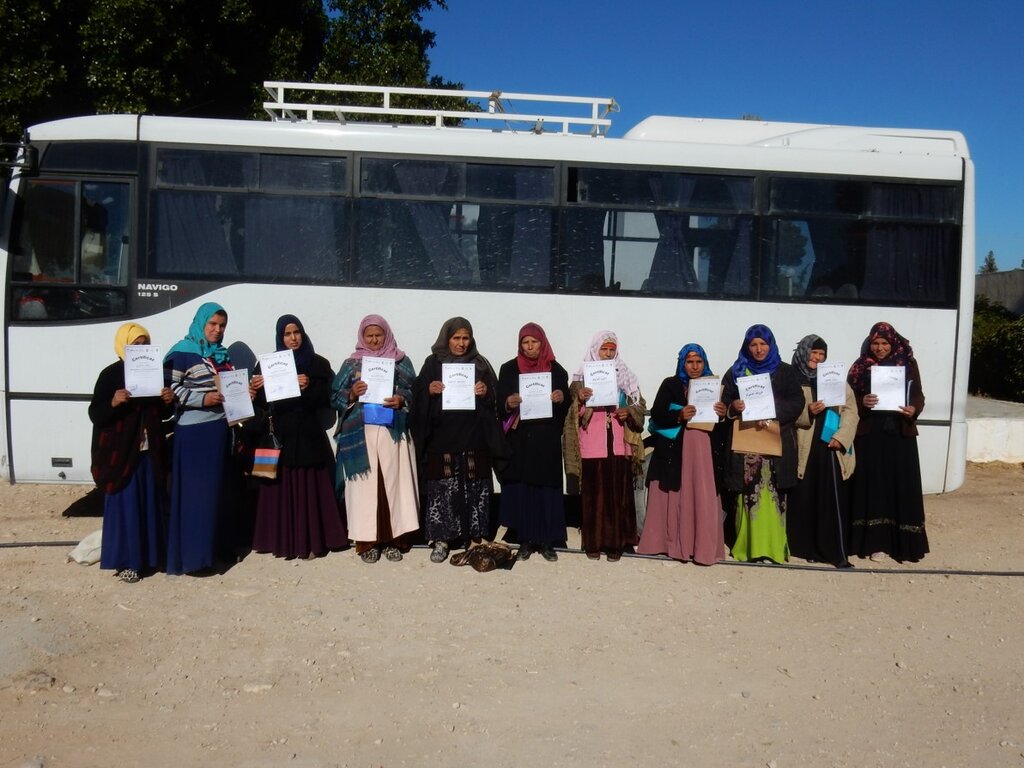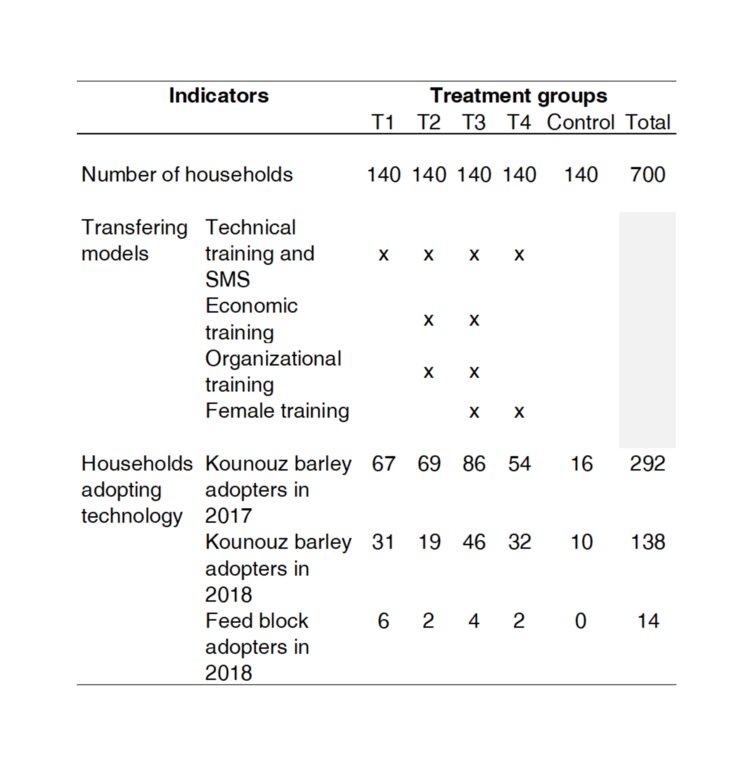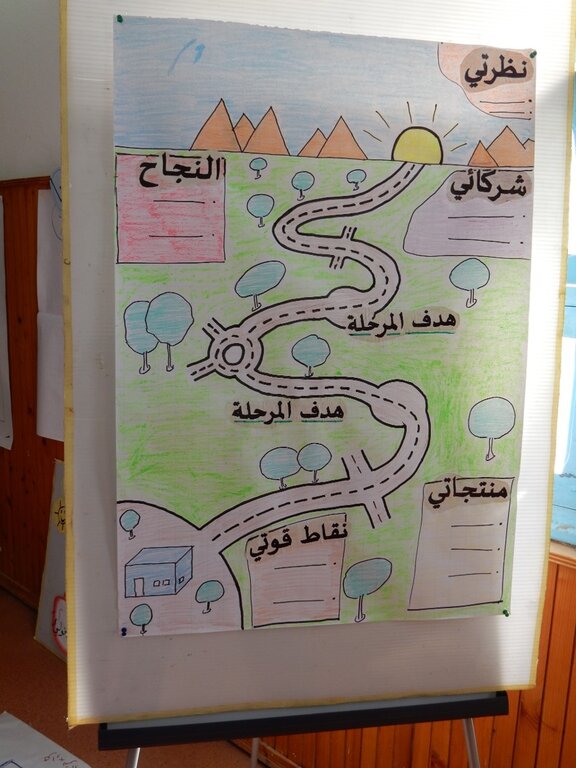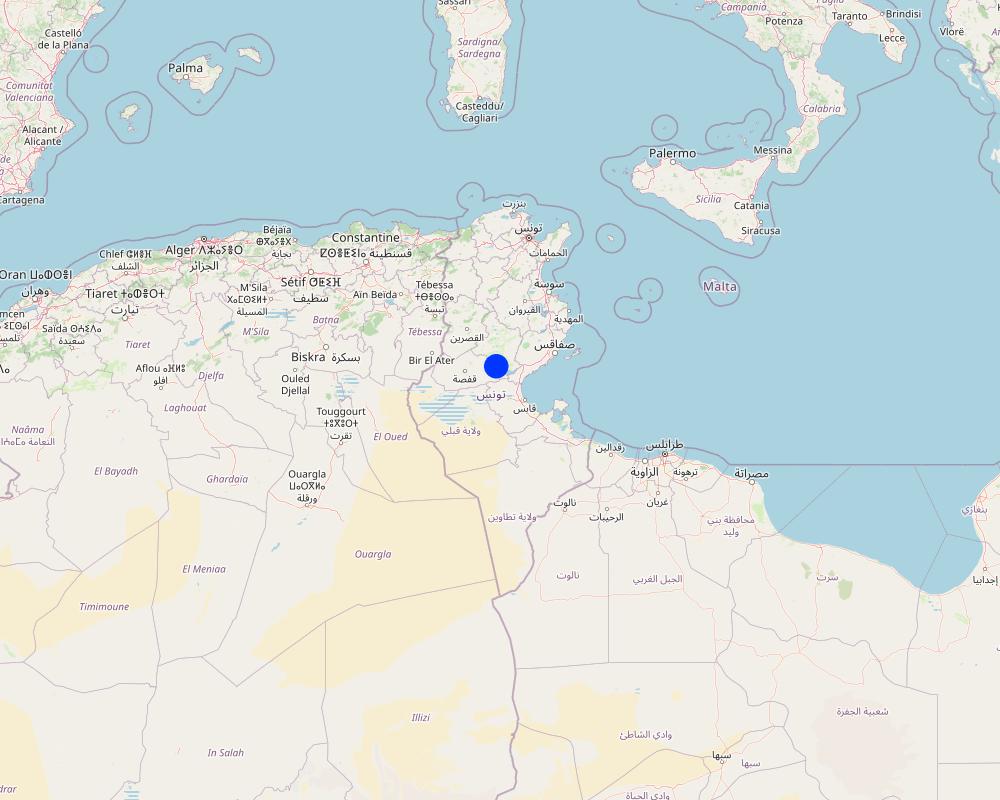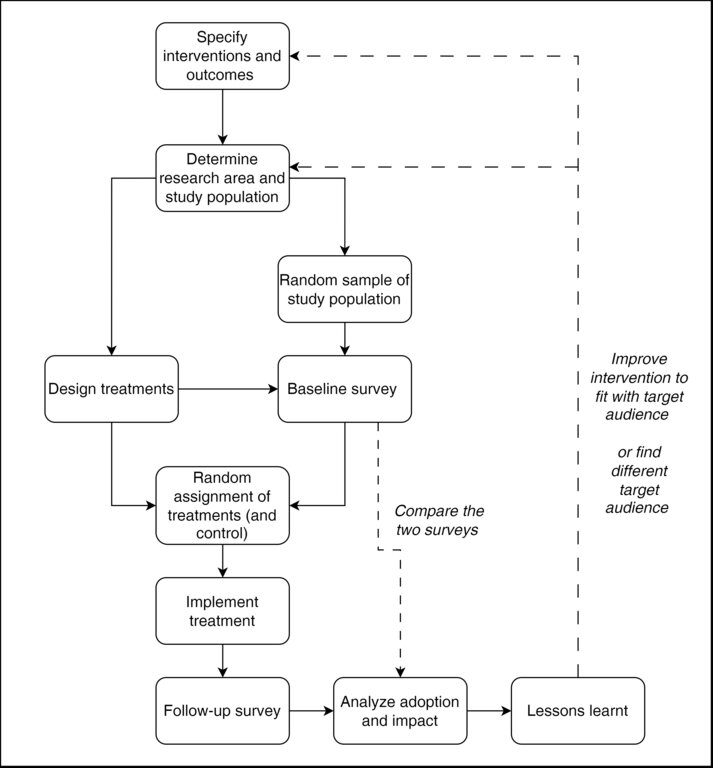Lessons learned from the "Mind the Gap" project: Improving Dissemination Strategies [ຕູນິເຊຍ]
- ການສ້າງ:
- ປັບປູງ:
- ຜູ້ສັງລວມຂໍ້ມູນ: Joren Verbist
- ບັນນາທິການ: –
- ຜູ້ທົບທວນຄືນ: William Critchley, Rima Mekdaschi Studer
approaches_7123 - ຕູນິເຊຍ
ເບິ່ງພາກສ່ວນ
ຂະຫຍາຍທັງໝົດ ຍຸບທັງໝົດ1. ຂໍ້ມູນທົ່ວໄປ
1.2 ລາຍລະອຽດ ການຕິດຕໍ່ ຂອງບຸກຄົນທີ່ຊັບພະຍາກອນ ແລະ ສະຖາບັນ ການມີສ່ວນຮ່ວມ ໃນການປະເມີນຜົນ ແລະ ເອກະສານ ຂອງວິທີທາງ
ບຸກຄົນສຳຄັນ (ຫຼາຍຄົນ)
Innovation specialist:
Rudiger Udo
International Center of Agricultural Research in Dry Areas (ICARDA)
ຕູນິເຊຍ
Gender specialist:
Najjar Dina
International Center of Agriculture Research in the Dry Areas (ICARDA)
ມໍລອກໂກ
Natural Resource Economist:
Dhehibi Boubaker
International Center of Agricultural Research in Dry Areas (ICARDA)
ຕູນິເຊຍ
Werner Jutta
German Ministry of Agriculture
Derbel Sondos
AVFA (National Agricultural Training and Extension Service)
ຊື່ຂອງໂຄງການ ທີ່ອໍານວຍຄວາມສະດວກ ໃນການສ້າງເອກກະສານ ຫຼື ປະເມີນດ້ານແນວທາງ (ຖ້າກ່ຽວຂ້ອງ)
ICARDA Institutional Knowledge Management Initiativeຊື່ຂອງ ສະຖາບັນການຈັດຕັ້ງ ທີ່ອໍານວຍຄວາມສະດວກ ໃນການສ້າງເອກກະສານ ຫຼື ປະເມີນແນວທາງ (ຖ້າກ່ຽວຂ້ອງ)
International Center for Agricultural Research in the Dry Areas (ICARDA) - ລີບານອນ1.3 ເງື່ອນໄຂ ຂອງການນໍາໃຊ້ເອກກະສານຂໍ້ມູນ ຂອງ WOCAT
ເມື່ອໃດທີ່ໄດ້ສັງລວມຂໍ້ມູນ (ຢູ່ພາກສະໜາມ)?
2019
ຜູ້ສັງລວມ ແລະ ບັນດາຜູ້ຕອບແບບສອບຖາມ ຍອມຮັບໃນເງື່ອນໄຂ ການນໍາໃຊ້ຂໍ້ມູນເອກະສານ ທີ່ສ້າງຂື້ນ ໂດຍຜ່ານ ອົງການ WOCAT:
ແມ່ນ
1.4 ເອກະສານອ້າງອີງ (ຫຼາຍ) ກັບແບບສອບຖາມ (ຫຼາຍ) ເຕັກໂນໂລຢີ ຂອງດ້ານການຄຸ້ມຄອງ ດິນແບບຍືນຍົງ
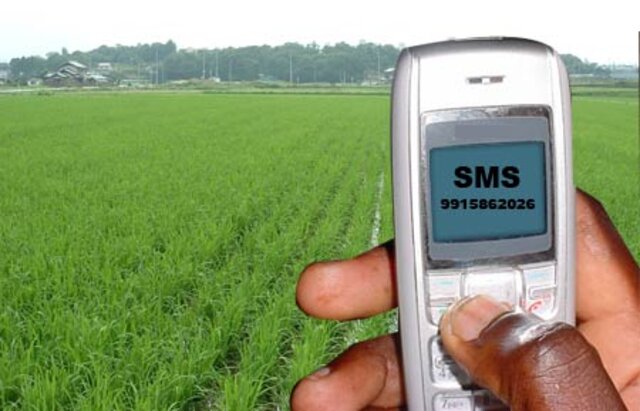
ICT2Scale – supporting smallholder farmers with cellphone-based services … [ຕູນິເຊຍ]
The ICT2Scale project contributes to better land management by supplying smallholder farmers with targeted SMS messages on diverse agricultural practices. This enables them to optimize resources and adopt more sustainable methods, consequently improving livelihoods in remote areas.
- ຜູ້ສັງລວມຂໍ້ມູນ: Joren Verbist
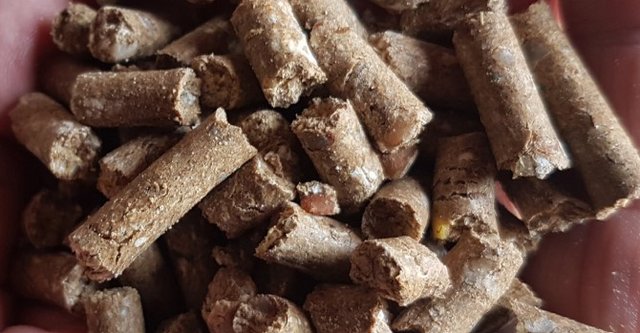
Small-Scale Nutrient-Dense Pellet Production [ຕູນິເຊຍ]
Compressing agro-industrial by-products produces nutrient-dense livestock feed pellets that can compete with expensive and imported alternatives. This innovation consists of a small-scale compressor or "pelletizer" and formulae to create feed pellets of sufficient quality with locally available inputs.
- ຜູ້ສັງລວມຂໍ້ມູນ: Joren Verbist
2. ພັນລະນາ ແນວທາງການຄຸ້ມຄອງນໍາໃຊ້ດິນແບບຍືນຍົງ
2.1 ການອະທິບາຍ ໂດຍຫຍໍ້ ຂອງວິທີທາງ
The “Mind the Gap” project researched the adoption gap between agricultural research and women and men farmers. Its objective was to determine most effective and cost-efficient technology transfer strategies and give recommendations to national extension institutes and development partners to adapt their scaling strategy
2.2 ການອະທິບາຍ ລາຍລະອຽດ ຂອງວິທີທາງ
ການອະທິບາຍ ລາຍລະອຽດ ຂອງວິທີທາງ:
Research into innovative agricultural technologies for the livestock-barley system in semi-arid Tunisia has yielded success. However, adoption of these has remained low for decades, not only in Tunisia but across developing countries (Noltze et al. 2012; DFID 2014; Syngenta Foundation 2015). Bridging this 'adoption gap' has proved to be a challenge, and there has been limited emphasis on improving agricultural extension methods. In this context, the International Center for Agricultural Research in Dry Areas (ICARDA) together with partners set up the "Mind the Gap" project, funded by the BMZ and GIZ.
This project aimed to fill this gap by developing and testing new models for transferring sustainable technology packages to smallholder farmers. Four transfer models were implemented across four test groups:
T1: Technical training and SMS.
T2: Technical training, SMS, economic, and organizational training.
T3: Technical training, SMS, economic and organizational training, with a focus on female empowerment.
T4: Technical training, SMS, and female empowerment.
The transferring models are thus (a) Technical training and SMS; (b) Economic training; (c) Organization training; (d) Female empowerment.
Technical training and SMS involved sending weekly text messages containing technical and organizational information to 560 farmer households from August 2017. Workshops were conducted in 2017 and 2018 to develop these messages in collaboration with regional extension services and other stakeholders.
Economic training included one-day sessions in 2017 to demonstrate the economic benefits of innovations. In 2018, a Farmer Business School (FBS) approach was adopted to enhance farmers' entrepreneurial skills, with a tailored curriculum and seven five-day courses delivered to 280 farmer households.
The organizational training aimed to enhance farmers' understanding cooperative management. Through classroom sessions and visits to existing cooperatives, farmers received insights into cooperative creation, management challenges, and the benefits of collective action.
Female empowerment activities engaged women from 280 farmer households, focusing on visits to female cooperatives and sensitization events to encourage their participation in agricultural activities and access to credit.
The adoption of two innovations was evaluated through this methodology. The first innovation, "Kounouz," is an improved barley variety designed to better withstand drought conditions. The second innovation involves feedblocks, also known as nutrient-dense pellets, which serve as an alternative livestock feed made from by-products.
The project rigorously evaluated these transfer models through randomized controlled trials, focusing on their impact on innovation adoption rates and cost-efficiency. The combined approach, carried out under T3, showed the highest adoption rates, particularly among female-headed households. Field visits were identified as a significant contributor to technology adoption, while SMS proved most cost-effective.
Most importantly, it showed that the four transferring models should be used in combination for the highest adoption.
In conclusion, the research underscores that addressing the 'adoption gap' in agricultural innovation requires comprehensive approaches encompassing technical, economic, organizational, and gender empowerment training. By combining these elements significant strides can be made in cost-efficiently enhancing technology adoption rates among smallholder farmers, offering valuable insights for agricultural extension efforts not only in Tunisia but also across the MENA region and potentially beyond.
Acknowledgement:
We would like to thank BMZ/ GIZ who supported this innovative research through their contributions to the “Mind the Gap” project as well as Tunisian NARES (INRAT, AVFA, OEP, CRDA) for co-implementing project activities.
2.3 ຮູບພາບຂອງແນວທາງ
2.5 ປະເທດ / ເຂດ / ສະຖານທີ່ບ່ອນທີ່ແນວທາງໄດ້ຖືກນໍາໃຊ້
ປະເທດ:
ຕູນິເຊຍ
Map
×2.6 ວັນທີເລີ່ມຕົ້ນ ແລະ ສິ້ນສຸດ ການຈັດຕັ້ງປະຕີບັດ ວິທີທາງ
ສະແດງປີຂອງການເລີ່ມຕົ້ນ:
2016
ປີທີ່ສີ້ນສູດ (ຖ້າຢຸດບໍ່ໄດ້ນໍາໃຊ້ ວິທີທາງ):
2019
2.7 ປະເພດຂອງແນວທາງ
- ພາຍໃຕ້ໂຄງການ / ແຜນງານ
2.8 ເປົ້າໝາຍ / ຈຸດປະສົງຫຼັກ ຂອງການຈັດຕັ້ງປະຕິບັດ ວິທີທາງ
To better understand the adoption gap of new sustainable farming technologies, and discover cost-efficient and effective approaches to improve adoption of these technologies.
2.9 ເງື່ອນໄຂອໍານວຍ ຫຼື ຂັດຂວາງການປະຕິບັດຂອງເຕັກໂນໂລຢີ / ເຕັກໂນໂລຢີການນໍາໃຊ້ຕາມແນວທາງ
ສັງຄົມ / ວັດທະນະທໍາ / ມາດຕະຖານ ແລະ ຄຸນຄ່າທາງສາສະໜາ
- ເຊື່ອງຊ້ອນ
Participation of women at trainings was sometimes low (no availability to due household tasks)
ມີຄວາມສາມາດ / ເຂັ້າເຖິງຊັບພະຍາກອນດ້ານການເງິນ ແລະ ການບໍລິການ
- ອໍານວຍ
Access to financial resources allowed purchase of technologies (Kounouz seeds or feed blocks)
ການກໍ່ຕັ້ງສະຖາບັນ
- ອໍານວຍ
The right institutions were selected (OEP, INRAT, AVFA) to implement MtG project activities
ການຮ່ວມມື / ການປະສານງານຂອງຜູ້ກ່ຽວຂ້ອງ
- ອໍານວຍ
Collaboration between the partners (NARES) was good and important; eg INRAT multiplied Kounouz seeds ; OEP and CRDA distributed Kounouz seeds and AVFA trained farmers on Kounouz production
ນະໂຍບາຍ
- ເຊື່ອງຊ້ອນ
Feed block production has strict regulations
ຄວາມຮູ້ກ່ຽວກັບການຄຸ້ມຄອງ ທີ່ດິນແບບຍືນຍົງ, ການເຂົ້າເຖິງການສະໜັບສະໜູນ ທາງດ້ານວິຊາການ
- ອໍານວຍ
Technical support to practice the technology (eg feed block composition) is important and was guaranteed by OEP
ຕະຫຼາດ (ໃນການຊື້ວັດຖຸດິບ, ຂາຍຜະລິດຕະພັນ) ແລະ ລາຄາ
- ເຊື່ອງຊ້ອນ
Prices of substitute feed like subsidized wheat bran and barley hinder the adoption of feed blocks.
ວຽກ, ມີກໍາລັງຄົນ
- ເຊື່ອງຊ້ອນ
Workload for feedblock production is high and manpower not always available.
3. ການມີສ່ວນຮ່ວມ ແລະ ບົດບາດຂອງພາກສ່ວນທີ່ກ່ຽວຂ້ອງທີ່ໄດ້ມີສ່ວນຮ່ວມ
3.1 ຜູ້ມີສ່ວນຮ່ວມ ໃນວິທີທາງ ແລະ ພາລະບົດບາດ ຂອງເຂົາເຈົ້າ
- ຜູ້ນໍາໃຊ້ດິນໃນທ້ອງຖິ່ນ / ຊຸມຊົນທ້ອງຖິ່ນ
No communities but individual farmers
Inviting farmers to trainings,
Organization of baseline and follow up survey with OEP
- ຜູ້ຊ່ຽວຊານ ການນຄຸ້ມຄອງ ທີ່ດິນແບບຍືນຍົງ / ທີ່ປຶກສາດ້ານກະສິກໍາ
AVFA (National Agricultural Training and Extension Service)
CTV (Local Extension Service)
OEP (Livestock and Pasture Office)
AVFA:
Organizational and economic trainings (FBS, BUS, cooperatives, etc) to 280 HH
Organized logistics (transport, restoration, training room)
OEP:
Technical training on feed blocks to 560 HH
Distribution of inputs to CTV, selection of cooperatives.
- ນັກຄົ້ນຄວ້າ
University of Goettingen
INRAT (National Agricultural Research Institute)
University of Goettingen:
Project development, PhD students, data collection for baseline and follow up survey
INRAT:
Development of new barley variety (Kounouz) in collaboration with ICARDA
Technical training on barley with OEP to 560 HH
- ອົງການຈັດຕັ້ງ ສາກົນ
ICARDA
GIZ
ICARDA: Overall technical and administrative coordination
GIZ: Trained AVFA trainers on FBS and BUS
ຖ້າຫາກມີຫຼາຍພາກສ່ວນທີ່ເຂົ້າຮ່ວມ ໃຫ້ລະບຸ ອົງການທີ່ເປັນຫຼັກ ໃນການຈັດຕັ້ງປະຕິບັດ:
ICARDA
3.2 ການມີສ່ວນຮ່ວມຂອງຜູ້ນໍາໃຊ້ທີ່ດິນໃນທ້ອງຖິ່ນ / ຊຸມຊົນທ້ອງຖິ່ນໃນໄລຍະທີ່ແຕກຕ່າງກັນຂອງແນວທາງ
| ການລວບລວມ ເອົາຜູ້ນໍາໃຊ້ດິນ ໃນທ້ອງຖິ່ນ / ຊຸມຊົນທ້ອງຖິ່ນ | ໃຫ້ລະບຸ ຜູ້ໃດທີ່ມີສ່ວນຮ່ວມ ໃນແຕ່ລະກິດຈະກໍາ? | |
|---|---|---|
| ການເລີ່ມຕົ້ນ / ແຮງຈູງໃຈ | ການບໍ່ປະຕິບັດ | The experiments were designed and set up by the research agency. |
| ການວາງແຜນ | ການບໍ່ປະຕິບັດ | Methodology was also determined by the research agency. |
| ການປະຕິບັດ | ການຮ່ວມມື | The approach to dissemination that proved successful was interactive. |
| ຕິດຕາມກວດກາ / ການປະເມີນຜົນ | ການບໍ່ປະຕິບັດ | The experiment was monitored by the research agency. |
3.3 ແຜນວາດ (ຖ້າມີ)
3.4 ການຕັດສິນໃຈກ່ຽວກັບການຄັດເລືອກເຕັກໂນໂລຢີຂອງການຄຸ້ມຄອງທີ່ດິນແບບຍືນຍົງ / ເຕັກໂນໂລຢີ
ລະບຸ ຄົນທີ່ຕັດສິນໃຈ ກ່ຽວກັບການຄັດເລືອກຂອງ ເຕັກໂນໂລຢີ / ເຕັກໂນໂລຢີ ຈະໄດ້ຮັບການປະຕິບັດ:
- ຜູ້ຊ່ຽວຊານ ຫຼັກດ້ານການຄຸ້ມຄອງ ທີ່ດິນແບບຍືນຍົງ, ມີການຕິດຕາມປຶກສາຫາລືກັບຜູ້ນໍາໃຊ້ທີ່ດິນ
ອະທິບາຍ:
There was a strong focus on research rather than implementation, which required scientific expertise rather than land user knowledge.
Specify on what basis decisions were made:
- ປະເມີນເອກກະສານ ຄວາມຮູ້ກ່ຽວກັບ ການຄຸ້ມຄອງ ທີ່ດິນແບບຍືນຍົງ (ຫຼັກຖານທີ່ຊ່ວຍໃນການຕັດສິນໃຈ)
- ຜົນທີ່ໄດ້ຮັບ ຈາກການຄົ້ນຄວ້າ
4. ການສະໜັບສະໜູນທາງດ້ານວິຊາການ, ການສ້າງຄວາມສາມາດ, ແລະ ການຈັດການຄວາມຮູ້.
4.1 ການສ້າງຄວາມສາມາດ / ການຝຶກອົບຮົມ
ຜູ້ນໍາໃຊ້ທີ່ດິນ ຫຼື ພາກສ່ວນກ່ຽວຂ້ອງອື່ນໆ ໄດ້ຮັບການຝຶກອົບຮົມບໍ່?
ແມ່ນ
ໃຫ້ລະບຸ ຜູ້ໃດທີ່ໄດ້ຮັບການຝຶກອົບຮົມ:
- ຜູ້ນໍາໃຊ້ດິນ
ຖ້າເປັນໄປໄດ້, ໃຫ້ລະບຸເພດ, ອາຍຸ, ສະຖານະພາບ, ຊົນເຜົ່າ, ແລະ ອື່ນໆ:
Land user, with a strong focus on females for two treatment groups.
ຮູບແບບຂອງການຝຶກອົບຮົມ:
- ຕົວຕໍ່ຕົວ
- ເນື້ອທີ່ສວນທົດລອງ
- ກອງປະຊຸມ
- ຫຼັກສູດ
ໃນຫົວຂໍ້:
The four main trainings were given:
-Technical with SMS
-Economic (e.g., better farm management)
-Organizational (e.g., setting up farmer cooperatives)
-Female empowerment
4.2 ການບໍລິການໃຫ້ຄໍາປຶກສາ
ເຮັດຜູ້ໃຊ້ທີ່ດິນມີການເຂົ້າເຖິງການບໍລິການໃຫ້ຄໍາປຶກສາ?
ແມ່ນ
ລະບຸວ່າການສະໜອງ ການບໍລິການ ໃຫ້ຄໍາປຶກສາ:
- ໃນພື້ນທີ່ຂອງຜູ້ນໍາໃຊ້ດິນ
- ສູນຄົ້ນຄວ້າ
ອະທິບາຍ / ຄວາມຄິດເຫັນ:
Advice was given through the training which included both on-site (e.g., demonstration fields) and meetings
4.3 ສະຖາບັນການສ້າງຄວາມເຂັ້ມແຂງ (ການພັດທະນາອົງການຈັດຕັ້ງ)
ສະຖາບັນ ໄດ້ຮັບການສ້າງຕັ້ງຂື້ນ ຫຼື ໄດ້ຮັບການສ້າງຄວາມເຂັ້ມແຂງ ໂດຍການຈັດຕັ້ງປະຕິບັດ ວິທີທາງບໍ່?
- ມີ, ພໍສົມຄວນ
ລະບຸ ທາງສະຖາບັນ ໄດ້ສ້າງຄວາມເຂັ້ມແຂງ ໃນລະດັບໃດ (ຫຼາຍ):
- ທ້ອງຖິ່ນ
ອະທິບາຍ ສະຖາບັນການຈັດຕັ້ງ, ພາລະບົດບາດ ແລະ ໜ້າທີ່ຮັບຜິດຊອບ, ສະມາຊິກ ແລະ ອື່ນໆ.
Training sessions regarding cooperation can be organized.
ລະບຸ ປະເພດ ຂອງສະໜັບສະໜູນ:
- ການສ້າງຄວາມອາດສາມາດ / ການຝຶກອົບຮົມ
4.4 ຕິດຕາມກວດກາ ແລະ ປະເມີນຜົນ
ການຈັດຕັ້ງປະຕິບັດ ວິທີທາງ ໄດ້ມີການປະເມີນຜົນ ແລະ ຕິດຕາມບໍ?
ແມ່ນ
ຄວາມຄິດເຫັນ:
Four treatment groups were made based on different combinations of training, they were evaluated for their adoption of Kounouz barley and feed blocks.
ຖ້າແມ່ນ, ເອກກະສານສະບັບນີ້ ແມ່ນໄດ້ນໍາໃຊ້ເຂົ້າໃນການຕິດຕາມ ແລະ ປະເມີນຜົນບໍ່?
ແມ່ນ
4.5 ການຄົ້ນຄວ້າ
ນີ້້ແມ່ນສ່ວນໜຶ່ງ ການຄົ້ນຄວ້າ ຂອງວິທີທາງບໍ່?
ແມ່ນ
ລະບຸ ຫົວຂໍ້:
- ສັງຄົມ
- ເສດຖະສາດ / ການຕະຫຼາດ
- ເຕັກໂນໂລຢີ
ໃຫ້ຂໍ້ມູນ ເພີ່ມເຕີມ ແລະ ກໍານົດ ຜູ້ໃດເຮັດການຄົ້ນຄວ້າ:
Several research papers were published with authors from different partners.
5. ການສະໜັບສະໜູນທາງດ້ານການເງິນ ແລະ ອຸປະກອນຈາກພາຍນອກ
5.1 ງົບປະມານປະຈໍາປີ ສໍາລັບວິທີທາງ ຂອງການຄຸ້ມຄອງ ທີ່ດິນແບບຍືນຍົງ
ສະແດງງົບປະມານ ປະຈໍາປີ ສໍາລັບອົງປະກອບ ຂອງວິທີທາງ ການຄຸ້ມຄອງ ທີ່ດິນແບບຍືນຍົງ ເປັນໂດລາສະຫະລັດ :
400000.00
ຄໍາເຫັນ (ຕົວຢ່າງ: ແຫຼ່ງຂໍ້ມູນຫຼັກ ຂອງການສະໜອງທຶນ / ຜູ້ໃຫ້ທຶນທີ່ສໍາຄັນ):
GIZ/BMZ
5.2 ການສະໜັບສະໜູນ ທາງດ້ານການເງິນ / ອຸປະກອນ ສະໜອງໃຫ້ແກ່ຜູ້ນໍາທີ່ດິນ
ຜູ້ນໍາໃຊ້ດິນ ໄດ້ຮັບການສະໜັບສະໜູນ ທາງດ້ານ ການເງິນ / ອຸປະກອນ ໃນການຈັດຕັ້ງປະຕິບັດ ເຕັກໂນໂລຢີບໍ?
ບໍ່ແມ່ນ
5.3 ເງິນສົມທົບສໍາລັບການນໍາໃຊ້ສະເພາະປັດໃຈຂາເຂົ້າໃນການຜະລີດກະສິກໍາ (ລວມທັງແຮງງານ)
- ບໍ່ມີ
5.4 ສິນເຊື່ອ
ໄດ້ປ່ອຍສິນເຊື່ອ ສະໜອງໃຫ້ພາຍໃຕ້ ວິທີການສໍາລັບກິດຈະກໍາ ການຄຸ້ມຄອງ ທີ່ດິນແບບຍືນນຍົງບໍ່?
ບໍ່ແມ່ນ
5.5 ສິ່ງຈູງໃຈ ຫຼື ເຄື່ອງມືອື່ນໆ
ການສົ່ງເສີມ ຈັດຕັ້ງປະຕິບັດ ເຕັກໂນໂລຢີ ໃນການຄຸ້ມຄອງ ດິນແບບຍືນຍົງ ໄດ້ສະໜອງສິ່ງກະຕຸກຊຸກຍູ້ບໍ່?
ບໍ່ແມ່ນ
6. ວິເຄາະຜົນກະທົບ ແລະ ສັງລວມບັນຫາ
6.1 ຜົນກະທົບຂອງແນວທາງ
ວິທີທາງ ຊ່ວຍຊຸກຍູ້ ຜູ້ນຳໃຊ້ທີ່ດິນທ້ອງຖີ່ນ, ໃນການປັບປຸງ ການມີສ່ວນຮ່ວມ ຂອງຜູ້ທີ່ກ່ຽວຂ້ອງ ບໍ່?
- ບໍ່
- ມີ, ໜ້ອຍໜຶ່ງ
- ມີ, ພໍສົມຄວນ
- ມີ, ຫຼາຍ
ການຈັດຕັ້ງປະຕິບັດ ວິທີທາງ ສາມາດຊ່ວຍຜູ້ນໍາໃຊ້ທີ່ດິນ ໃນການຈັດຕັ້ງປະຕິບັດ ແລະ ບໍາລຸງຮັກສາ ເຕັກໂນໂລຢີ ການຄຸ້ມຄອງ ທີ່ດິນແບບຍືນຍົງໄດ້ບໍ?
- ບໍ່
- ມີ, ໜ້ອຍໜຶ່ງ
- ມີ, ພໍສົມຄວນ
- ມີ, ຫຼາຍ
ການນໍາໃຊ້ ວິທີທາງ ສາມາດລະດົມ ຫຼື ປັບປຸງ ການເຂົ້າເຖິງຊັບພະຍາກອນ ການເງິນ ສໍາລັບການຈັດຕັ້ງປະຕິບັດ ການຄຸ້ມຄອງ ທີ່ດິນແບບຍືດຍົງໄດ້ບໍ່?
- ບໍ່
- ມີ, ໜ້ອຍໜຶ່ງ
- ມີ, ພໍສົມຄວນ
- ມີ, ຫຼາຍ
ການຈັດຕັ້ງປະຕິບັດ ວິທີທາງ ສາມາດປັບປຸງ ຄວາມສະເໜີພາບ ຂອງບົດບາດ ຍິງຊາຍ ແລະ ສ້າງຄວາມເຂັ້ມແຂງໃຫ້ຜູ້ຍິງໄດ້ບໍ່?
- ບໍ່
- ມີ, ໜ້ອຍໜຶ່ງ
- ມີ, ພໍສົມຄວນ
- ມີ, ຫຼາຍ
ການນໍາໃຊ້ ວິທີທາງ ໄດ້ປັບປຸງ ການຄໍ້າປະກັນສະບຽງອາຫານ ຫຼື ປັບປຸງໂຄສະນາການໄດ້ບໍ່?
- ບໍ່
- ມີ, ໜ້ອຍໜຶ່ງ
- ມີ, ພໍສົມຄວນ
- ມີ, ຫຼາຍ
6.2 ແຮງຈູງໃຈຫຼັກຂອງຜູ້ນໍາໃຊ້ທີ່ດິນໃນການປະຕິບັດການຄຸ້ມຄອງທີ່ດິນແບບຍືນຍົງ
- ການຜະລິດເພີ່ມຂຶ້ນ
- ກໍາໄລເພີ່ມຂຶ້ນ (ຄວາມສາມາດ), ການປັບປຸງຄ່າໃຊ້ຈ່າຍ, ຜົນປະໂຫຍດ, ອັດຕາສ່ວນ
- ຫຼຸດຜ່ອນຄວາມສ່ຽງຂອງໄພພິບັດ
- ລວມເຂົ້ານໍາກັນກັບການເຄື່ອນໄຫວ / ໂຄງການ / ກຸ່ມ / ເຄືອຂ່າຍ
- ການປັບປຸງ ຄວາມຮູ້ ແລະ ຄວາມສາມາດ ຂອງການຄຸ້ມຄອງ ທີ່ດິນແບບຍືນຍົງ
6.3 ຄວາມຍືນຍົງຂອງກິດຈະກໍາວິທີທາງ
ຜູ້ນໍາໃຊ້ ທີ່ດິນ ສາມາດສືບຕໍ່ ການຈັດຕັ້ງປະຕິບັດ ຜ່ານວິທີທາງໄດ້ບໍ່ (ໂດຍປາດສະຈາກ ການຊ່ວຍເຫຼືອ ຈາກພາກສ່ວນພາຍນອກ)?
- ແມ່ນ
6.4 ຈຸດແຂງ / ຂໍ້ດີ ຂອງວິທີທາງ
| ຈຸດແຂງ / ຈຸດດີ / ໂອກາດ ຈາກທັດສະນະຂອງຜູ້ປ້ອນຂໍ້ມູນ ຫຼື ບຸກຄົນສຳຄັນ |
|---|
| Highest adoption rate for Kounouz was in T3 (61% in 2017 and 33% in 2018) where the whole package of extension was provided (technical training, SMS + economic and organizational training +female empowerment + access to input). This indicates that different adoption models should be combined rather than singled out. |
| The treatment groups T3 and T4 which received the female empowerment training have the highest Kounouz variety adoption rates in 2018 (T3 = 33%, T4 =24%). The implication of women in the project has a positive influence on the adoption of innovative technologies. The gender dimension should be considered as a vector of adoption of new technologies especially in Tunisian agriculture. |
|
In terms of cost, the government can choose according to the available budgetary resources: i) Highest level of technology adoption with the highest cost of trainings 34% in T3 with a total cost of trainings estimated at 900 TND per person ii) Medium technology adoption rate with a lower cost of trainings 22% in T1 with a total cost of trainings estimated to 230 TND per person). T3 is most effective but T1 is more cost efficient. |
| The strong collaboration between four public research and extension institutions (OEP, INRAT, AVFA and CTV) and one international agricultural institution (ICARDA) is one of the important factors for adoption and transfer of knowledge |
6.5 ຈຸດອ່ອນ / ຂໍ້ເສຍຂອງແນວທາງ ແລະ ວິທີການແກ້ໄຂໃຫ້ເຂົາເຈົ້າ
| ຈຸດອ່ອນ ຫຼື ຂໍ້ເສຍ ຫຼື ຄວາມສ່ຽງ ໃນມຸມມອງຂອງ ຜູ້ສັງລວມຂໍ້ມູນ ຫຼື ບັນດາຜູ້ຕອບແບບສອບຖາມ | ມີວິທີການແກ້ໄຂຄືແນວໃດ? |
|---|---|
| Concerning the technical extension methods, the field visit (with an intermediate cost) especially done in the similar areas is more efficient than the training (with a high cost) and the SMS text message (with a very low cost). | However, these extension methods are complementary and encourage the project’s farmers to adopt innovative technologies. |
7. ເອກກະສານອ້າງອີງ ແລະ ຂໍ້ມູນການເຊື່ອມໂຍງ
7.1 ວິທີການ / ແຫຼ່ງຂໍ້ມູນ
- ການໄປຢ້ຽມຢາມພາກສະໜາມ, ການສໍາຫຼວດພາກສະໜາມ
- ສໍາພາດ ຊ່ຽວຊານ ການຄຸ້ມຄອງ ດິນແບບຍືນຍົງ
- ການລວບລວມ ບົດລາຍງານ ແລະ ເອກະສານອື່ນໆ ທີ່ມີຢູ່ແລ້ວ
7.3 ການເຊື່ອມຕໍ່ກັບຂໍ້ມູນທີ່ກ່ຽວຂ້ອງທີ່ສາມາດໃຊ້ອອນໄລນ໌
ຫົວຂໍ້ / ພັນລະນາ:
Boubaker Dhehibi, Mohamed Zied Dhraief, Udo Rudiger, Aymen Frija, Jutta Werner, Liza Straussberger, Barbara Rischkowsky. (13/4/2022). Impact of improved agricultural extension approaches on technology adoption: Evidence from a randomised controlled trial in rural Tunisia. Experimental Agriculture, 58, pp. 1-16.
URL:
https://hdl.handle.net/20.500.11766/67344
ຫົວຂໍ້ / ພັນລະນາ:
Boubaker Dhehibi, Udo Rudiger. (24/12/2019). Synthesis Mind the Gap.
URL:
https://hdl.handle.net/20.500.11766/10505
ຫົວຂໍ້ / ພັນລະນາ:
Udo Rudiger. (16/12/2019). Mind the Gap: Improving Dissemination Strategies to Increase Technology Adoption by Smallholders. Beirut, Lebanon: International Center for Agricultural Research in the Dry Areas (ICARDA).
URL:
https://hdl.handle.net/20.500.11766/10471
ຫົວຂໍ້ / ພັນລະນາ:
Samar Zaidi, Boubaker Dhehibi, Mohamed Zied Dhraief, Mohamed Arbi Abdeladhim. (22/3/2023). Résilience des ménages face à l’insécurité alimentaire et au changement climatique dans les régions du centre et du nord-est de la Tunisie: Une analyse empirique. New Medit, 22 (1), pp. 19-34.
URL:
https://hdl.handle.net/20.500.11766/68229
ຫົວຂໍ້ / ພັນລະນາ:
Boubaker Dhehibi, Jutta Werner, Matin Qaim. (7/3/2018). Designing and Conducting Randomized Controlled Trials (RCTs) for Impact Evaluations of Agricultural Development Research: A Case Study from ICARDA’s ‘Mind the Gap’ Project in Tunisia. Beirut, Lebanon: International Center for Agricultural Research in the Dry Areas (ICARDA).
URL:
https://hdl.handle.net/20.500.11766/8209
ຫົວຂໍ້ / ພັນລະນາ:
Boubaker Dhehibi, Jutta Werner, Hloniphani Moyo. (18/9/2018). Developing a policy framework for agricultural extension systems in Tunisia. Beirut, Lebanon: International Center for Agricultural Research in the Dry Areas (ICARDA).
URL:
https://hdl.handle.net/20.500.11766/8390
ຫົວຂໍ້ / ພັນລະນາ:
Quang Bao Le, Jutta Werner, Boubaker Dhehibi, Mounir Louhaichi, Chandrashekhar Biradar. (10/11/2019). Functionally context socio-ecological type (fCSET) approach to support outscaling of agricultural innovation options.
URL:
https://hdl.handle.net/20.500.11766/10801
ຫົວຂໍ້ / ພັນລະນາ:
Boubaker Dhehibi, Udo Rudiger, Mohamed Zied Dhraief. (9/9/2019). Factors Influencing Farmers’ Decisions to Adopt Improved Technologies in Semi-Arid Farming Systems: A case study of the barley variety Kounouz and feed blocks technology in Tunisia. Beirut, Lebanon: International Center for Agricultural Research in the Dry Areas (ICARDA).
URL:
https://hdl.handle.net/20.500.11766/10223
ຫົວຂໍ້ / ພັນລະນາ:
Hloniphani Moyo, Jutta Werner, Boubaker Dhehibi, Udo Rudiger, Cherifa Saidi. (14/4/2019). Improving dissemination strategies to increase technology adoption by smallholder farmers in Tunisia. Beirut, Lebanon: International Center for Agricultural Research in the Dry Areas (ICARDA).
URL:
https://hdl.handle.net/20.500.11766/9813
ຂໍ້ມູນການເຊື່ອມຕໍ່ ແລະ ເນື້ອໃນ
ຂະຫຍາຍທັງໝົດ ຍຸບທັງໝົດການເຊື່ອມຕໍ່

ICT2Scale – supporting smallholder farmers with cellphone-based services … [ຕູນິເຊຍ]
The ICT2Scale project contributes to better land management by supplying smallholder farmers with targeted SMS messages on diverse agricultural practices. This enables them to optimize resources and adopt more sustainable methods, consequently improving livelihoods in remote areas.
- ຜູ້ສັງລວມຂໍ້ມູນ: Joren Verbist

Small-Scale Nutrient-Dense Pellet Production [ຕູນິເຊຍ]
Compressing agro-industrial by-products produces nutrient-dense livestock feed pellets that can compete with expensive and imported alternatives. This innovation consists of a small-scale compressor or "pelletizer" and formulae to create feed pellets of sufficient quality with locally available inputs.
- ຜູ້ສັງລວມຂໍ້ມູນ: Joren Verbist
ເນື້ອໃນ
ບໍ່ມີເນື້ອໃນ



